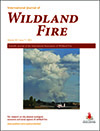International Journal of Wildland Fire
Volume 30
Number 7 2021
This study measured the environmental temperature and the heat flux received by firefighters during real wildland fires. This provides a realistic vision of the thermal stress and risk of heat burns that firefighters may experience in real scenarios. Data from this study may help to maximise workers’ safety.
Fire thunderstorms (pyroCbs) are becoming increasingly common and are the most dangerous form of pyroconvection. We use idealised numerical model simulations to determine how the size of a fire and the atmospheric stability can influence pyroconvection. These findings confirm the connection between deep flaming and the development of pyroCbs.
Continuing the work from Part I, we investigated how the shape of a fire is as important as the total heat released (fire power) to the development of pyrocumulonimbus (pyroCb), using the isoperimetric ratio as a measure. The findings further confirmed the connection between deep flaming and the development of pyroCb.
Abrupt wind shifts due to thunderstorm outflows can suddenly change wildfire behaviour and spread, endangering the lives of firefighters. This paper describes a software tool that can objectively identify these wind shifts in the output of numerical weather forecast models and help fire weather forecasters to enhance firefighter safety.
We analysed the success of prescribed fires and fire suppression operations in mitigating the severity of a 2012 wildfire in northern California that burned under severe conditions. Prescribed fire and operations each were moderately successful in reducing wildfire severity and a combination of both strongly reduced wildfire severity.
Treed peatlands have different smouldering fire potentials across the Boreal Plains, Alberta, Canada. These ecosystems, which can experience high-severity fire and produce vast smoke emissions, are common features near communities, industry and infrastructure in the region. Hence, smouldering fire potential assessments should be included in wildfire management operations and decision-making.
This paper describes the influence of spring fire on a population of threatened Desmoulin’s whorl snail and its habitat. Low survivorship was expected after a fire due to its low mobility and sensitivity to habitat changes. Although this population did survive the fire, there was a sharp decline in numbers.





